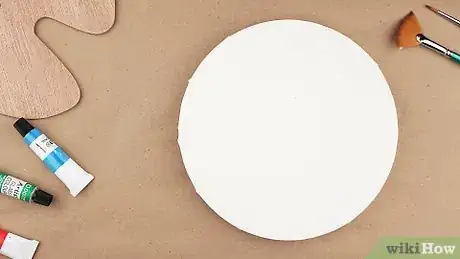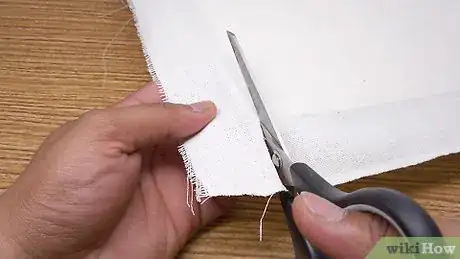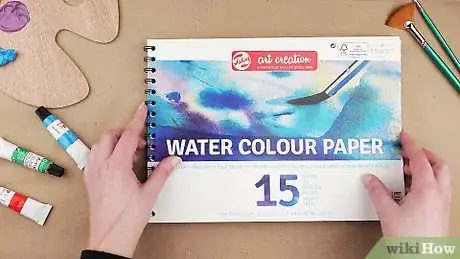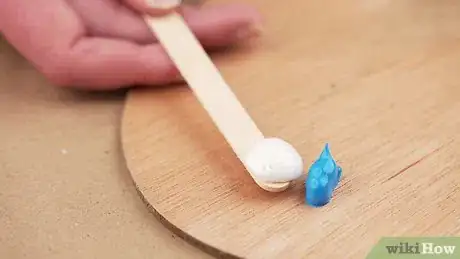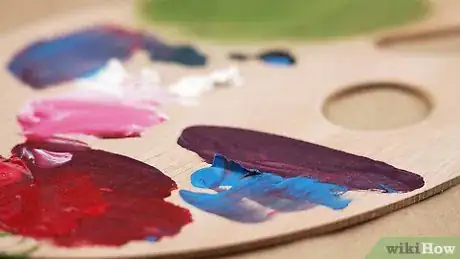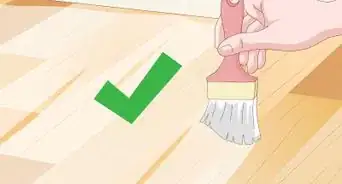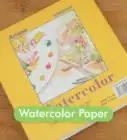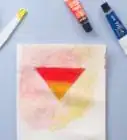This article was co-authored by Kelly Medford and by wikiHow staff writer, Amy Bobinger. Kelly Medford is an American painter based in Rome, Italy. She studied classical painting, drawing and printmaking both in the U.S. and in Italy. She works primarily en plein air on the streets of Rome, and also travels for private international collectors on commission. She founded Sketching Rome Tours in 2012 where she teaches sketchbook journaling to visitors of Rome. Kelly is a graduate of the Florence Academy of Art.
There are 23 references cited in this article, which can be found at the bottom of the page.
wikiHow marks an article as reader-approved once it receives enough positive feedback. This article received 22 testimonials and 100% of readers who voted found it helpful, earning it our reader-approved status.
This article has been viewed 609,448 times.
If you're feeling artistic, acrylic paint is a great medium to work with. It's really versatile—you can use it to paint a variety of surfaces, and it's easy to create a lot of different textures and effects. It also dries quickly, so you don't have to wait as long between layers as you would if you were using oil paint. However, you do have to be careful that the paint doesn't dry out while you're working with it. If you're ready to create your next masterpiece, we're here to answer your most important questions about working with acrylic paint!
Steps
What is the best canvas for acrylic paint?
-
1Choose a primed, stretched canvas for a simple option. If you're a beginning painter, canvas will be your go-to painting surface. The easiest way to buy canvas is to purchase one that's already stretched over a wooden frame. These are often primed in advance, as well.[1]
-
2Go with unprimed, unstretched canvas to save money. Unstretched canvases are typically sold as fabric wound on a large roll. You'll need to stretch the canvas tightly and nail it to a wooden frame.[2] Then, paint a layer of gesso on the canvas and allow it to dry before you begin painting.[3]Advertisement
-
3Opt for a thick watercolor paper if you'd like to use watered-down acrylic. If you like the watercolor look but prefer to use acrylic paint, try painting on art paper that's at least 300 lb. weight. Since art paper is cheaper than canvas, this can be a good way to experiment with acrylics.[4]
- Keep in mind that paper will absorb some of the paint, so your finished work won't be as vivid as it would if you used a non-porous surface like primed canvas or wood.
- If you use thinner paper, it will wrinkle or warp, and it may tear.
How do you keep acrylic paint from drying out?
-
1Mist your palette every 10-15 minutes while you paint. Fill a small spray bottle with water and keep it close at hand. About every 10-15 minutes or so, spritz the water over the paint that's on the palette. This should help prevent the paint from hardening while you're working.[13]
- If the paint dries in your palette, add more of the same color on top of it. If the dried paint is too built up, you can also scrape it out to get a fresh start.
-
2Use a stay-wet palette to keep the paint wet longer. You can either purchase a stay-wet palette, or you can make your own by stacking together about 6-10 sheets of paper towels. Soak the paper towels thoroughly, then place them in a tray and put the paint directly onto the paper towels.[14]
What brushes should you use for acrylic paint?
-
1Use large, flat brushes to outline the shapes of your subject. When you're starting an acrylic painting, start by creating the rough shapes of the objects in your picture. For example, if you're painting a scenic mountain view, begin by outlining the bold contours of the mountain peaks.[15]
- If you have a large background area, you may want to put down the base color after you paint your outlines. Then, fill in any details later in the process.
- You might find it helpful to work with opaque acrylic colors while painting outlines—typically, this will be color straight from the tube. Then, when you're detailing the painting, work with more transparent colors, or paint that's been thinned with water or a thinning medium.
-
2Use smaller brushes to add details to your painting. Once you've completed the major shapes of your painting, pick up your smaller detail brushes. Use these to add touches of detail, like fine lines or texture. Try out a variety of fine-tipped brushes to create different sized lines and visual effects on your canvas.[16]
- For example, once you've contoured the large mountain peaks, use smaller, more pointed brushes for filling in details like individual trees, a lake, or campers on the shore.
-
3Experiment with brush shapes to create different effects. The shape of the brush will have a big impact on how the paint looks when you apply it to the canvas. Try keeping a variety of brushes on hand so you can easily add variety and detail. For example, you might use:[17]
- Round brushes for lines and detail work
- Flat brushes for making big, bold strokes and filling in large spaces
- Fan brushes for blending and feathering
- Angular flat brushes for filling in corners and fine details
Do you wet the brush before using acrylic paint?
-
1Use a wet brush to get even coverage on your canvas. Most of the time, you'll use a wet brush to work with acrylic paint. This will allow the brush to glide evenly over the surface of the canvas, so the paint will evenly coat the background. This is especially helpful when you're painting a large area or shadowy backgrounds, but you should wet the brush any time you want a solid color on the canvas.[18]
-
2Try a dry brush to add more texture and detail work to the painting. If the brush is dry, it will skip a little when you run it across the surface of your painting. This will give the paint a grainy look, so it's great for areas where you want to add a little bit of texture or detail.[19]
- For instance, you might dry brush the ground in your painting to create the appearance of grass.
- If you're dry brushing, be sure to blot the brush dry thoroughly if you rinse it between colors.[20]
How do you thin out acrylic paint?
-
1Make the color more translucent by adding water. When applied straight from the tube, acrylic paints can look thick and opaque. Change the paint's opacity by adding more water to the paint that's on your palette. The more water you add to the paint, the more transparent the color will become.[21]
- When you're mixing acrylic paint with water, don't add more than about 20% water compared to the paint. If you use more than that, the binding agent that makes the paint stick to the surface might fail, causing the paint to peel off once it's dry.
-
2Thin out acrylics with glaze or paste to change the texture of the paint. If you only use straight acrylic paint on a canvas, the entire painting will have a bland, uniform texture. Thinning out the acrylics with mix-ins will vary the visual textures. So, mix in other mediums, such as glaze or texture paste, when thinning the acrylic. In general, thinning out your acrylic paint will give it a liquid, watery look once it's dried.[22]
- Glazes will give the dried paint a satiny color and a bright, shiny texture.
- Texture pastes add a rough, chunky texture to the paint, but may dampen the color a bit after drying.
- Don't use more than about 30% of your chosen medium, or else the paint might not coat the surface of your canvas.
Can you layer acrylic paints?
-
1Yes, work in layers to create texture and dimension. When you're working with acrylic paints, it's best to work in layers. This will allow you to create dimension, like creating shadows and highlights in a tree by using varying shades of green.[24]
- Leave enough time for each layer of paint to dry before you paint another layer over it. Thin layers will dry in about 30 minutes, while thick layers will take over 1 hour to dry.
-
2Add dark colors and broad shapes, then move to light colors and detail. When you start painting, lay down your outlines, large shapes, and any shadowy areas first. Use the darkest colors that you've laid out on your palette. Then, as you add each new layer, gradually lighten the colors, adding detail, texture, and highlights.[25]
- Acrylic paints don't mix once they've dried. If you start painting with the lightest colors first, then go over them with darker colors, the darker colors will just cover up the lighter paint—they won't become lighter.
- This is just a general rule—sometimes if you add too much highlight, you may need to go in and fill in a little detail with a darker color. That's totally fine!
- If you're used to working with watercolors, you'll notice that this is the opposite of that process, where you always work from lightest to darkest.
How do you create texture with acrylic paint?
-
1Splatter paint with a wet brush to make thick chunks of color. Dip a paintbrush or toothbrush into water and then coat the bristles with paint. Hold the brush firmly in one hand, then strike the brush right below the bristles with the other hand. The paint will fly off in thick clots and stick to the canvas.[26]
- Splattering is a great technique to use if you're making an abstract art piece. Or, try splattering to add texture to your painting.
- Try holding the brush about 2–3 in (5.1–7.6 cm) from the canvas to control the spatter area. You can also use masking tape to block off any areas you don't want splattered.
-
2Create a stipple effect by dotting the paint on the canvas. To stipple, coat the bristles of a paintbrush in paint, then tap the tip of the paintbrush gently against the canvas to create a feathered, dotted effect. This would work well for painting birds or animals, or to bring a feathery texture into an abstract work.[27]
- When you're stippling, never slide the bristles along the canvas. This will smear the stipples together and ruin the effect.
- You can also dip a sponge in paint, then dab the sponge lightly on the canvas to create a bubbly effect.
Expert Q&A
Did you know you can get premium answers for this article?
Unlock premium answers by supporting wikiHow
-
QuestionHow can I start painting with acrylics?
 Kelly MedfordKelly Medford is an American painter based in Rome, Italy. She studied classical painting, drawing and printmaking both in the U.S. and in Italy. She works primarily en plein air on the streets of Rome, and also travels for private international collectors on commission. She founded Sketching Rome Tours in 2012 where she teaches sketchbook journaling to visitors of Rome. Kelly is a graduate of the Florence Academy of Art.
Kelly MedfordKelly Medford is an American painter based in Rome, Italy. She studied classical painting, drawing and printmaking both in the U.S. and in Italy. She works primarily en plein air on the streets of Rome, and also travels for private international collectors on commission. She founded Sketching Rome Tours in 2012 where she teaches sketchbook journaling to visitors of Rome. Kelly is a graduate of the Florence Academy of Art.
Professional Artist
-
QuestionWhat should a beginner paint?
 wikiHow Staff EditorThis answer was written by one of our trained team of researchers who validated it for accuracy and comprehensiveness.
wikiHow Staff EditorThis answer was written by one of our trained team of researchers who validated it for accuracy and comprehensiveness.
Staff Answer wikiHow Staff EditorStaff AnswerIt’s a good idea to start with simple subjects that will help you get a feel for the paints and what they can do. A still life, or a painting of a small collection of objects, is a good exercise for beginning painters. Choose some interesting objects, such as some pieces of pottery or an assortment of fruits and vegetables with different colors and textures, and arrange them in a visually pleasing way. Experiment with painting the objects and capturing things like shape, depth, light, shadow, and texture.
wikiHow Staff EditorStaff AnswerIt’s a good idea to start with simple subjects that will help you get a feel for the paints and what they can do. A still life, or a painting of a small collection of objects, is a good exercise for beginning painters. Choose some interesting objects, such as some pieces of pottery or an assortment of fruits and vegetables with different colors and textures, and arrange them in a visually pleasing way. Experiment with painting the objects and capturing things like shape, depth, light, shadow, and texture. -
QuestionHow do I get better at painting with acrylics?
 wikiHow Staff EditorThis answer was written by one of our trained team of researchers who validated it for accuracy and comprehensiveness.
wikiHow Staff EditorThis answer was written by one of our trained team of researchers who validated it for accuracy and comprehensiveness.
Staff Answer wikiHow Staff EditorStaff Answer
wikiHow Staff EditorStaff Answer
References
- ↑ https://www.art-is-fun.com/canvas-art-supplies
- ↑ https://www.art-is-fun.com/canvas-art-supplies
- ↑ Kelly Medford. Professional Artist. Expert Interview. 2 July 2019.
- ↑ https://www.art-is-fun.com/acrylic-painting-supplies-for-beginners
- ↑ https://youtu.be/_IbEYYThDzI?t=88
- ↑ https://youtu.be/FFqdWg4XT1c?t=108
- ↑ https://youtu.be/_IbEYYThDzI?t=88
- ↑ https://www.creativebloq.com/art/8-top-acrylic-painting-tips-artists-31619738
- ↑ https://youtu.be/SLX5iOuq0pY?t=15
- ↑ https://www.craftsy.com/post/how-to-mix-acrylic-paint/#
- ↑ Kelly Medford. Professional Artist. Expert Interview. 2 July 2019.
- ↑ https://lorimcnee.com/beginners-guide-using-acrylic-paints/
- ↑ https://www.art-is-fun.com/how-to-stop-acrylic-paint-from-drying-too-fast
- ↑ https://www.art-is-fun.com/how-to-stop-acrylic-paint-from-drying-too-fast
- ↑ https://youtu.be/_nBOWe_VhXg?t=28
- ↑ https://youtu.be/_nBOWe_VhXg?t=109
- ↑ https://www.art-is-fun.com/artist-paint-brushes
- ↑ https://www.shelleysbrushworks.com/painting-tips-blog/wet-brushing-dry-brushing-part-1what-is-the-difference-between-the-two
- ↑ https://www.explore-acrylic-painting.com/dry-brush-technique.html
- ↑ https://lorimcnee.com/beginners-guide-using-acrylic-paints/
- ↑ https://youtu.be/h9HEeXud7mg?t=32
- ↑ https://www.artistsnetwork.com/art-mediums/acrylic/how-to-thin-acrylic-paint-painting-with-acrylics-for-beginners/
- ↑ creativebloq.com/art/8-top-acrylic-painting-tips-artists-31619738
- ↑ https://youtu.be/TYpH3xsZ2X4?t=19
- ↑ https://youtu.be/TYpH3xsZ2X4?t=19
- ↑ Kelly Medford. Professional Artist. Expert Interview. 2 July 2019.
- ↑ https://stepbysteppainting.net/2018/01/30/acrylic-painting-brush-techniques/
- ↑ https://lorimcnee.com/beginners-guide-using-acrylic-paints/
- ↑ https://paintingcreativity.com/how-to-clean-a-paint-palette/
- ↑ https://paintingcreativity.com/how-to-clean-a-paint-palette/
- ↑ https://artpassiononline.com/things-you-didnt-know-you-could-use-acrylic-paint-on/
About This Article
When you’re painting with acrylics, start by choosing a primed, stretched canvas to work on. Next, squeeze out a small amount of paint onto your palette and spray it with water occasionally, since acrylic paint tends to dry out quickly. Then, paint larger outlines or backgrounds first, and work your way to smaller details. If you need to thin out the paint to create a translucent effect, add a small amount of water or mineral spirits. For tips on mixing colors to create new ones, read on!
